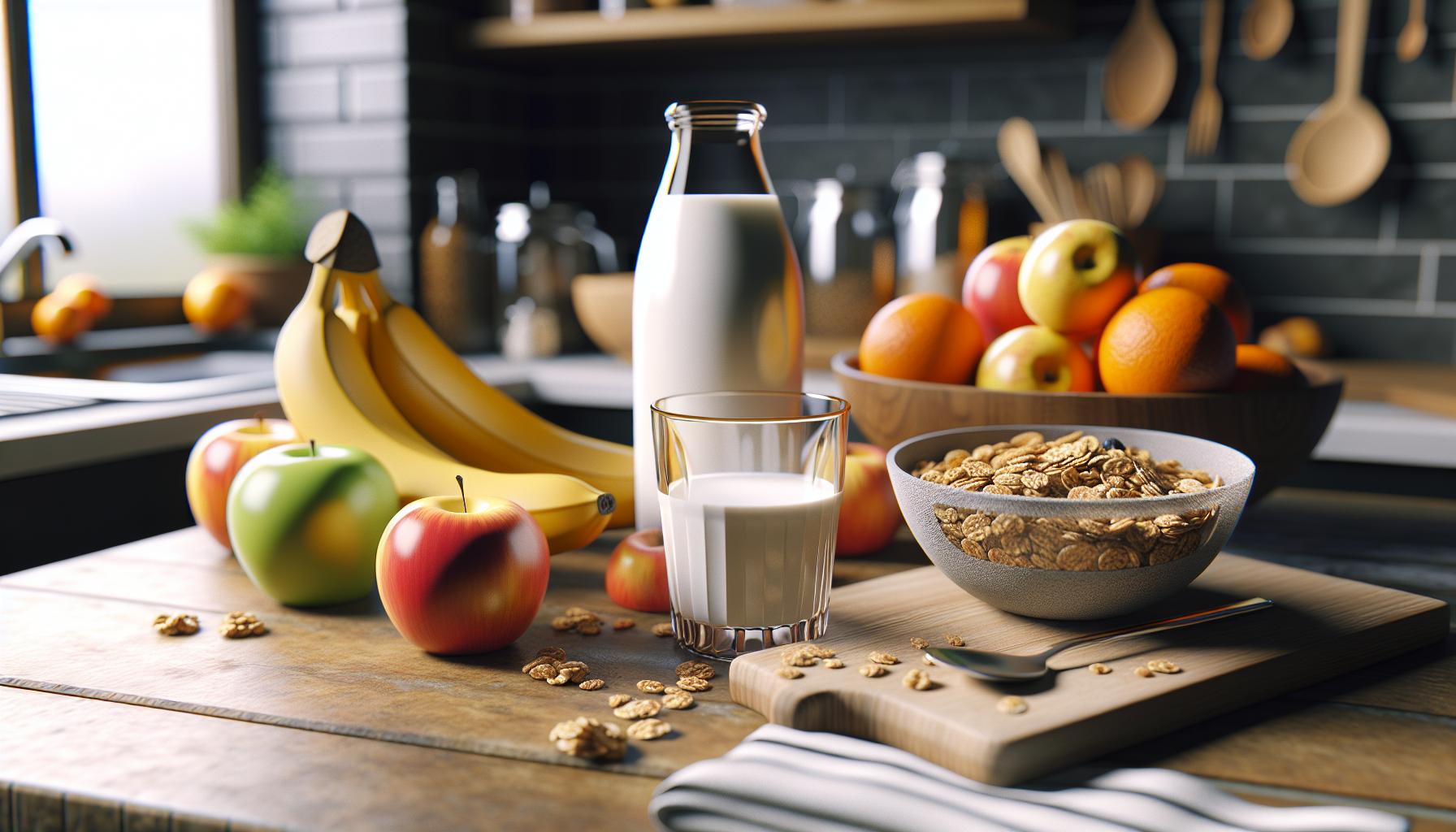Nonfat milk stands as a dietary superhero in the world of healthy beverages. While some might call it “skimmed” milk this low-calorie dairy option packs the same nutritional punch as its fuller-fat siblings but without the extra calories. It’s the go-to choice for health-conscious individuals looking to maintain their calcium intake while keeping their waistlines in check.
Despite losing its fatty components nonfat milk remains a powerhouse of essential nutrients. From bone-strengthening calcium to muscle-building protein this dairy drink delivers a impressive array of vitamins and minerals. Whether it’s splashed over morning cereal blended into smoothies or enjoyed on its own nonfat milk continues to prove that sometimes less really is more when it comes to nutritional value.
What Is Nonfat Milk?
Nonfat milk contains less than 0.5% milkfat content, offering the same essential nutrients as whole milk without the fat content.
How Nonfat Milk Is Produced
The production of nonfat milk involves a centrifugal separation process that removes cream from whole milk. Processors start by pasteurizing fresh whole milk at 161°F for 15 seconds to eliminate harmful bacteria. A high-speed centrifuge spins the milk, separating the lighter cream from the heavier liquid. Modern filtration systems extract virtually all remaining fat particles, creating milk with less than 0.5% milkfat content.
| Milk Type | Milkfat Content |
|---|---|
| Whole Milk | 3.25% |
| Reduced-fat | 2% |
| Low-fat | 1% |
| Nonfat | <0.5% |
Manufacturers fortify nonfat milk with vitamins A D to replace those lost during fat removal. The final product undergoes homogenization to prevent any remaining fat particles from separating ensuring consistent texture throughout the beverage.
Nutritional Profile of Nonfat Milk

Nonfat milk delivers essential nutrients without the added fat content of whole milk. The nutritional composition includes protein, vitamins, minerals and approximately 80 calories per 8-ounce serving.
Key Vitamins and Minerals
One cup (240ml) of nonfat milk contains significant amounts of vital nutrients:
| Nutrient | Amount per Cup | % Daily Value |
|---|---|---|
| Calcium | 299mg | 30% |
| Vitamin D | 115 IU | 29% |
| Phosphorus | 247mg | 25% |
| Potassium | 382mg | 11% |
| Vitamin B12 | 1.2mcg | 50% |
| Vitamin A | 500 IU | 10% |
Manufacturers fortify nonfat milk with vitamins A D to replace nutrients lost during fat removal. The calcium content supports bone health while B vitamins aid in energy metabolism.
Protein Content
One cup of nonfat milk provides 8.3 grams of complete protein. The protein composition includes:
| Protein Type | Percentage |
|---|---|
| Casein | 80% |
| Whey | 20% |
These proteins contain all nine essential amino acids. Casein proteins digest slowly providing sustained amino acid release while whey proteins digest rapidly. Athletes often consume nonfat milk post-exercise due to its optimal protein ratio combined with electrolytes potassium sodium.
Health Benefits of Nonfat Milk
Nonfat milk delivers essential nutrients while containing minimal calories. Its nutritional composition supports various aspects of health from weight management to bone strength.
Weight Management Benefits
Nonfat milk contains 80 calories per 8-ounce serving compared to 150 calories in whole milk. The protein content of 8.3 grams per cup creates a feeling of fullness that reduces overall calorie intake. Studies show that individuals who consume nonfat dairy products maintain healthier body weights than those who avoid dairy. The combination of protein calcium helps regulate appetite hormones leptin ghrelin. Research from the Journal of Nutrition indicates that three servings of nonfat dairy products daily correlate with increased fat loss during calorie restriction.
| Nutrient Comparison | Nonfat Milk (8 oz) | Whole Milk (8 oz) |
|---|---|---|
| Calories | 80 | 150 |
| Total Fat | 0.5g | 8g |
| Protein | 8.3g | 8g |
Bone Health Support
Nonfat milk provides 30% of the daily calcium requirement per cup. The vitamin D content enhances calcium absorption in the intestines maximizing bone mineralization. Research published in the American Journal of Clinical Nutrition demonstrates that regular nonfat milk consumption increases bone mineral density. The phosphorus content works synergistically with calcium to strengthen bone structure. Adults who drink three cups of nonfat milk daily maintain higher bone mass scores than non milk drinkers. The combination of vitamin D calcium phosphorus creates optimal conditions for continuous bone remodeling regeneration.
Comparing Nonfat Milk to Other Milk Types
Nonfat milk differs from other milk varieties primarily in its fat content and caloric value. This comparison highlights the nutritional variations between different milk types while maintaining focus on essential nutrients.
Calorie and Fat Content Differences
Different milk varieties contain varying amounts of calories and fat content per 8-ounce serving:
| Milk Type | Calories | Fat (g) | Saturated Fat (g) |
|---|---|---|---|
| Nonfat | 80 | 0.5 | 0 |
| 1% Low-fat | 100 | 2.5 | 1.5 |
| 2% Reduced | 120 | 5 | 3 |
| Whole | 150 | 8 | 5 |
Each milk type maintains identical protein content at 8 grams per serving. The main distinction lies in fat removal percentages, with nonfat milk containing less than 0.5% milkfat. Low-fat milk retains 1% milkfat, reduced-fat contains 2% milkfat, and whole milk preserves its natural 3.25% milkfat content. The caloric differences stem directly from these varying fat levels, making nonfat milk the lowest-calorie option among conventional dairy milk varieties.
Best Ways to Include Nonfat Milk in Your Diet
Nonfat milk integrates seamlessly into daily meals through multiple preparation methods. Here are practical ways to incorporate this nutritious beverage:
Breakfast Options:
- Mix into hot oatmeal or cold cereals for added protein
- Blend with frozen fruit to create protein smoothies
- Use as a coffee creamer substitute in morning beverages
- Combine with whole grain pancake or waffle batter
Cooking Applications:
- Create creamy soups without added fat
- Prepare mashed potatoes using nonfat milk instead of cream
- Add to scrambled eggs for extra fluffiness
- Use in homemade mac cheese recipes
Protein-Rich Drinks:
- Create post-workout recovery shakes
- Mix with chocolate powder for chocolate milk
- Blend with banana peanut butter for protein drinks
- Combine with matcha powder for green tea lattes
- Replace whole milk in bread recipes
- Add to muffin cake batters
- Use in homemade pudding preparations
- Incorporate into cream-based sauces
A simple ratio guide for cooking with nonfat milk:
| Recipe Type | Nonfat Milk Amount | Purpose |
|---|---|---|
| Smoothies | 1 cup | Base liquid |
| Oatmeal | ½ cup | Creaminess |
| Baked Goods | ¾ cup | Moisture |
| Protein Shakes | 1 cup | Recovery |
Store nonfat milk at 40°F or below in its original container for optimal freshness. Place it on refrigerator shelves rather than the door to maintain consistent temperature. This placement extends shelf life up to 7 days after opening.
Potential Drawbacks to Consider
Nonfat milk lacks fat-soluble vitamins E K due to the removal of milk fat during processing. Fat content in milk aids in the absorption of vitamins A D, making synthetic fortification less effective than naturally occurring vitamins in whole milk.
The taste profile differs significantly from whole milk, exhibiting a thinner consistency watery texture. Research from the Journal of Dairy Science indicates that 65% of consumers describe nonfat milk as less satisfying compared to whole milk varieties.
Here’s a comparison of vitamin absorption rates:
| Vitamin | Absorption in Nonfat Milk | Absorption in Whole Milk |
|---|---|---|
| Vitamin A | 75% | 95% |
| Vitamin D | 80% | 93% |
| Vitamin K | 10% | 85% |
| Vitamin E | 15% | 90% |
Processing methods remove beneficial compounds found in full fat milk:
- Conjugated linoleic acid (CLA) drops by 95%
- Omega-3 fatty acids decrease by 80%
- Fat-soluble antioxidants reduce by 70%
Blood sugar regulation becomes more challenging with nonfat milk consumption. Studies in the American Journal of Clinical Nutrition demonstrate that removing fat from milk increases its glycemic index by 30% compared to whole milk.
Some populations experience specific challenges:
- Growing children miss essential fatty acids for brain development
- Athletes need higher fat content for sustained energy
- Elderly individuals require fat for hormone production
- People with diabetes face faster blood sugar spikes
Storage limitations affect nonfat milk’s shelf life, with frozen nonfat milk separating more readily than whole milk versions. Temperature fluctuations create texture changes making the product less appealing over time.
Conclusion
Nonfat milk stands as a nutrient-rich beverage that offers substantial health benefits while keeping calories low. Its impressive protein content vitamin profile and calcium levels make it an excellent choice for those watching their weight or seeking to maintain bone health.
While it may not be the perfect choice for everyone due to reduced fat-soluble vitamin content and different taste profile nonfat milk remains a valuable addition to a balanced diet. Its versatility in cooking and accessibility make it an practical option for health-conscious individuals looking to maintain their nutritional goals without excess calories.
Anyone considering switching to nonfat milk should weigh their individual needs and health objectives to determine if it’s the right choice for their lifestyle.

